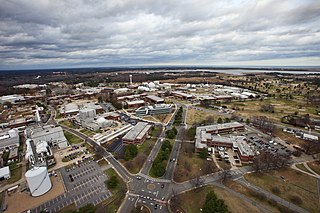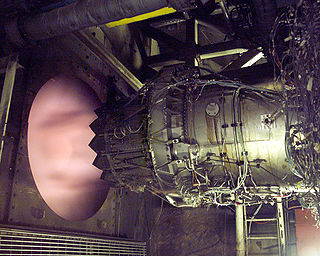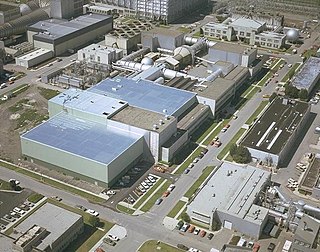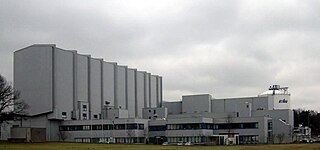
Mach number is a dimensionless quantity in fluid dynamics representing the ratio of flow velocity past a boundary to the local speed of sound.

Wind tunnels are large tubes with air blowing through them which are used to replicate the interaction between air and an object flying through the air or moving along the ground. Researchers use wind tunnels to learn more about how an aircraft will fly. NASA uses wind tunnels to test scale models of aircraft and spacecraft. Some wind tunnels are large enough to contain full-size versions of vehicles. The wind tunnel moves air around an object, making it seem as if the object is flying.

The Ames Research Center (ARC), also known as NASA Ames, is a major NASA research center at Moffett Federal Airfield in California's Silicon Valley. It was founded in 1939 as the second National Advisory Committee for Aeronautics (NACA) laboratory. That agency was dissolved and its assets and personnel transferred to the newly created National Aeronautics and Space Administration (NASA) on October 1, 1958. NASA Ames is named in honor of Joseph Sweetman Ames, a physicist and one of the founding members of NACA. At last estimate NASA Ames has over US$3 billion in capital equipment, 2,300 research personnel and a US$860 million annual budget.

The National Advisory Committee for Aeronautics (NACA) was a United States federal agency founded on March 3, 1915, to undertake, promote, and institutionalize aeronautical research. On October 1, 1958, the agency was dissolved and its assets and personnel were transferred to the newly created National Aeronautics and Space Administration (NASA). NACA is an initialism, i.e., pronounced as individual letters, rather than as a whole word.

The Langley Research Center, located in Hampton, Virginia, United States, is the oldest of NASA's field centers. It directly borders Langley Air Force Base and the Back River on the Chesapeake Bay. LaRC has focused primarily on aeronautical research, but has also tested space hardware at the facility, such as the Apollo Lunar Module. In addition, a number of the earliest high-profile space missions were planned and designed on-site, and Langley was considered a potential site for NASA's Manned Space Center prior to the eventual selection of Houston, Texas.

The Boeing YC-14 is a twinjet short take-off and landing (STOL) tactical military transport aircraft. It was Boeing's entrant into the United States Air Force's Advanced Medium STOL Transport (AMST) competition, which aimed to replace the Lockheed C-130 Hercules as the USAF's standard STOL tactical transport. Although both the YC-14 and the competing McDonnell Douglas YC-15 were successful, neither aircraft entered production. The AMST project was ended in 1979 and replaced by the C-X program.

Arnold Air Force Base is a United States Air Force base located in Coffee and Franklin counties, Tennessee, adjacent to the city of Tullahoma. It is named for General Henry "Hap" Arnold, the father of the U.S. Air Force.

A hypersonic wind tunnel is designed to generate a hypersonic flow field in the working section, thus simulating the typical flow features of this flow regime - including compression shocks and pronounced boundary layer effects, entropy layer and viscous interaction zones and most importantly high total temperatures of the flow. The speed of these tunnels vary from Mach 5 to 15. The power requirement of a wind tunnel increases with the cross section, the flow density and is directly proportional to the third power of the test velocity. Hence installation of a continuous, closed circuit wind tunnel remains a costly affair. The first continuous Mach 7-10 wind tunnel with 1x1 m test section was planned at Kochel am See, Germany during WW II and finally put into operation as 'Tunnel A' in the late 1950s at AEDC Tullahoma, TN, USA for an installed power of 57 MW. In view of these high facility demands, also intermittently operated experimental facilities like blow-down wind tunnels are designed and installed to simulate the hypersonic flow. A hypersonic wind tunnel comprises in flow direction the main components: heater/cooler arrangements, dryer, convergent/divergent nozzle, test section, second throat and diffuser. A blow-down wind tunnel has a low vacuum reservoir at the back end, while a continuously operated, closed circuit wind tunnel has a high power compressor installation instead. Since the temperature drops with the expanding flow, the air inside the test section has the chance of becoming liquefied. For that reason, preheating is particularly critical.

The Unitary Plan Wind Tunnel, located at the NASA Ames Research Center in Moffett Federal Airfield, Mountain View, California, United States, is a research facility used extensively to design and test new generations of aircraft, both commercial and military, as well as NASA space vehicles, including the Space Shuttle. The facility was completed in 1955 and is one of five facilities created after the 1949 Unitary Wind Tunnel Plan Act supporting aeronautics research.
The University of Texas at Arlington Aerodynamics Research Center (ARC) is a facility located in the southeast portion of the campus operated under the Department of Mechanical and Aerospace Engineering. It was established in 1986 as part of an expansion of UTA's College of Engineering. The ARC contributes to the vision of UTA and the University of Texas System to transform the university into a full-fledged research institution. It showcases the aerodynamics research activities at UTA and, in its history, has established itself as a unique facility at a university level. The wind tunnels and equipment in the facility were mainly built by scouting for and upgrading decommissioned equipment from the government and industry. Currently, Masters and Ph.D. students perform research in the fields of high-speed gas dynamics, propulsion, and Computational fluid dynamics among other projects related to aerodynamics.
A Trisonic Wind Tunnel (TWT) is a wind tunnel so named because it is capable of testing in three speed regimes – subsonic, transonic, and supersonic. The earliest known trisonic wind tunnel was dated to 1950 and was located in El Segundo, California before it closed in 2007. Other trisonic wind tunnels currently in operation are those located at NASA's Marshall Space Flight Center and the French-German Research Institute of Saint-Louis.

The Full-Scale Tunnel was a wind tunnel at NASA's Langley Research Center. It was a National Historic Landmark.

The Eight-Foot High Speed Tunnel, also known as Eight-Foot Transonic Tunnel, was a wind tunnel located in Building 641 of NASA's Langley Research Center in Hampton, Virginia. It was a National Historic Landmark.
Expansion and shock tunnels are aerodynamic testing facilities with a specific interest in high speeds and high temperature testing. Shock tunnels use steady flow nozzle expansion whereas expansion tunnels use unsteady expansion with higher enthalpy, or thermal energy. In both cases the gases are compressed and heated until the gases are released, expanding rapidly down the expansion chamber. The tunnels reach speeds from Mach 3 to Mach 30 to create testing conditions that simulate hypersonic to re-entry flight. These tunnels are used by military and government agencies to test hypersonic vehicles that undergo a variety of natural phenomenon that occur during hypersonic flight.
The Aeronautical/Astronautical Research Laboratory (AARL) is an aerospace engineering research facility operated by Ohio State University. It is the principal research facility of the College of Engineering's Department of Aerospace and Astronautical Engineering. It is located on the grounds of Ohio State University Airport, in Columbus, Ohio.

The European transonic wind tunnel (ETW) is a high-Reynolds-number transonic wind tunnel using nitrogen as test gas.

The Conroy Virtus was a proposed American large transport aircraft intended to carry the Space Shuttle. Designed, beginning in 1974, by John M. Conroy of the Turbo-Three Corporation, it was to incorporate a pair of Boeing B-52 Stratofortress fuselages to form a new craft using existing parts for cost-savings. While the project was seriously considered, it proved impractically large and NASA chose to develop the Boeing 747-based Shuttle Carrier from surplus commercial aircraft instead.
As the coalition of Bay Areas counties predicted when it lobbied for the creation of Moffett Federal Airfield in the late 1920s, the base's research program and facilities catalyzed the development of numerous private technology and aerospace corporations, among them Lockheed Martin and the Hiller Aircraft Corporation.

The Propeller Research Tunnel (PRT) was the first full-scale wind tunnel at the National Advisory Committee for Aeronautics (NACA) Langley Research Center, and the third at the facility. It was in use between 1927 and 1950 and was instrumental in the drag reduction research of early American aeronautics. In 1929, NACA was awarded its first Collier Trophy for the NACA cowling which was tested and developed using the Propeller Research Tunnel.

















